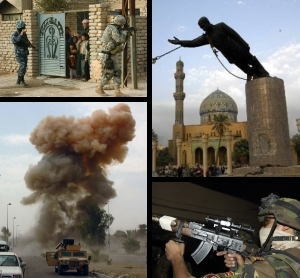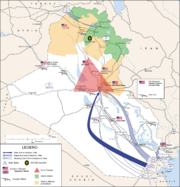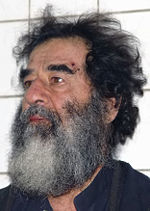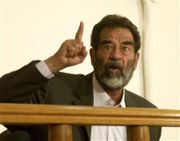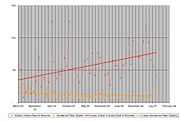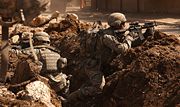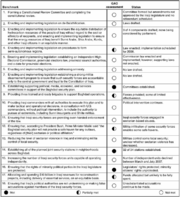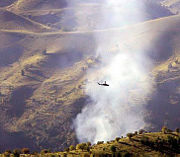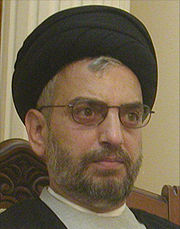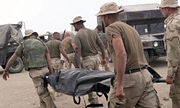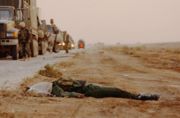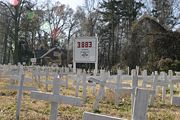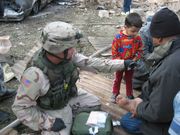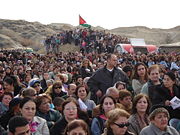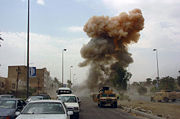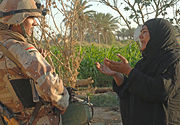Iraq War
2008/9 Schools Wikipedia Selection. Related subjects: Conflict and Peace; Military History and War; Recent History
|
||||||||||||||||||||||||||||||||
|
||||||||||||||||||||||||||||||||
|
||||||||||||||||||||||||||||||||
|
||||||||||||||||||||||||||||||||
The Iraq War, also known as the Second Gulf War, Operation Iraqi Freedom, or the occupation of Iraq, is an ongoing conflict which began on March 20, 2003 with the United States-led invasion of Iraq by a multinational coalition composed of U.S. and U.K. troops supported by smaller contingents from Australia, Poland, and other nations.
The rationale for the invasion offered by U.S. President George W. Bush and coalition supporters included the allegation that Iraq possessed and was actively developing weapons of mass destruction (WMD) in violation of a 1991 agreement. U.S. officials argued that Iraq posed an imminent, urgent, and immediate threat to the United States, its people, allies, and interests. The supporting intelligence was widely criticized, and weapons inspectors found no evidence of WMD. After the invasion, the Iraq Survey Group concluded that Iraq had ended its WMD programs in 1991 and had none at the time of the invasion, but that they intended to resume production if and when the Iraq sanctions were lifted. Although some earlier degraded remnants of misplaced or abandoned WMD were found, they were not the weapons for which the coalition invaded. Some U.S. officials claimed Saddam Hussein and al-Qaeda were cooperating, but no evidence of any collaborative relationship has been found. Other reasons for the invasion stated by officials included concerns about Iraq's financial support for the families of Palestinian suicide bombers, Iraqi government human rights abuses, spreading democracy, and Iraq's oil reserves.
The invasion led to the quick defeat of the Iraqi army and flight of President Saddam Hussein, his capture in December, 2003, and his execution in December, 2006. The U.S.-led coalition occupied Iraq and attempted to establish a new democratic government. But shortly after the initial invasion, violence against coalition forces and among various sectarian groups led to asymmetric warfare with the Iraqi insurgency, civil war between many Sunni and Shia Iraqis, and al-Qaeda operations in Iraq. Estimates of the number of people killed range from over 150,000 to more than 1 million. The financial cost of the war has been more than $491 billion to the U.S., and over £4.5 billion to the UK. Coalition nations have begun to withdraw troops as public opinion favoring troop withdrawal increases and Iraqi forces begin to take responsibility for security.
1991–2003: U.N. inspectors and the no-fly zones
Following the 1991 Gulf War, the United Nations Security Council Resolution 687 mandated that Iraqi chemical, biological, nuclear, and long range missile programs be halted and all such weapons destroyed under a United Nations Special Commission control. U.N. weapons inspectors inside Iraq were able to verify the destruction of a large amount of WMD-material, but substantial issues remained unresolved after they left Iraq in 1998 due to current UNSCOM head Richard Butler's belief that U.S. and U.K. military action was imminent. Shortly after the inspectors withdrew, the U.S. and U.K. launched a four-day bombing campaign .
In addition to the inspection regimen, the United States and the United Kingdom (along with France until 1998) engaged in a low-level conflict with Iraq by enforcing northern and southern Iraqi no-fly zones. These zones were created following the Persian Gulf War to protect Iraqi Kurdistan in the north and the southern Shia areas, and were seen by the Iraqi government as an infringement of Iraq's sovereignty. Iraqi air-defense installations and American and British air patrols regularly exchanged fire during this period.
In April 2001, Bush's Cabinet agreed to use military intervention in Iraq, because it was considered a destabilizing influence to the flow of oil to international markets from the Middle East. Neoconservatives in the U.S. called for the sell-off of all of Iraq's oil fields and planned for a coup d'etat in long before the September 11th attacks, hoping a new government would use, "Iraq's oil to destroy the OPEC cartel through massive increases in production above OPEC quotas." Those plans were abandoned shortly after the invasion because former Shell Oil Company CEO Philip Carroll, who had been charged with their implementation, refused to be involved with Iraqi oil industry privatization because it could have led to the exclusion of U.S. firms, unlike the state-run oil ministry. U.S. oil industry consultant Falah Aljibury alleges that soon after Bush took office in 2001, he took part in secret meetings in Washington, the Middle East, and California involving an overthrow of the Iraq regime. Aljibury told BBC's Newsnight that he, "interviewed potential successors to Saddam Hussein on behalf of the Bush administration."
Approximately a year before Operation Iraqi Freedom, the United States initiated Operation Southern Focus as a change to its response strategy, by increasing the overall number of missions and selecting targets throughout the no-fly zones to disrupt the military command structure in Iraq. The weight of bombs dropped increased from none in March 2002 and 0.3 in April 2002 to between 8 and 14 tons per month in May-August, reaching a pre-war peak of 54.6 tons in September 2002.
2001–2003: Iraq disarmament crisis and pre-war intelligence
U.N. weapons inspections resume
The issue of Iraq's disarmament reached a crisis in 2002-2003, when President George W. Bush demanded a complete end to alleged Iraqi production of weapons of mass destruction and full compliance with UN Resolutions requiring UN weapons inspectors unfettered access to suspected weapons production facilities. Previously, the UN had prohibited Iraq from developing or possessing such weapons since the 1991 Gulf War and required Iraq to permit inspections confirming Iraqi compliance.
During 2002, Bush repeatedly backed demands for unfettered inspection and disarmament with threats of military force. In accordance with UN Security Council Resolution 1441 Iraq reluctantly agreed to new inspections in late 2002. The results of these inspections were mixed with no discovery of WMDs and skepticism of Iraqi WMD program declarations.
Alleged weapons of mass destruction
In the initial stages of the war on terror, the Central Intelligence Agency, under George Tenet, was rising to prominence as the lead agency in the Afghanistan war. But when Tenet insisted in his personal meetings with President Bush that there was no connection between Al Qaeda and Iraq, V.P. Dick Cheney and Secretary of Defense Donald Rumsfeld initiated a secret program to re-examine the evidence and marginalize the CIA and Tenet. The questionable intelligence acquired by this secret program was " stovepiped" to the Vice President and presented to the public. In some cases, Cheney’s office would leak the intelligence to reporters, where it would be reported by outlets such as The New York Times. Cheney would subsequently appear on the Sunday political television talk shows to discuss the intelligence, referencing The New York Times as the source to give it credence.
In late February 2002, the CIA sent former Ambassador Joseph Wilson to investigate dubious claims about Iraq's attempted purchase of yellowcake uranium from Niger. Wilson returned and informed the CIA that reports of yellowcake sales to Iraq were "unequivocally wrong." However, the Bush administration continued to allege attempts to obtain yellowcake as justification for military action - most prominently in the January, 2003, State of the Union when President Bush said that Iraq had sought uranium, citing British intelligence sources. In response, Wilson wrote a critical The New York Times op-ed in June 2003 saying that he had personally investigated claims of yellowcake purchases and believed them to be fraudulent. Wilson's report did not clarify the matter for analysts, but they found it interesting that the former Nigerien Prime Minister said an Iraqi delegation had visited Niger for what he believed was to discuss uranium sales. Shortly after Wilson's op-ed, the identity of Wilson's wife, undercover CIA analyst Valerie Plame, was revealed in a column by Robert Novak. Since it is a felony to reveal the identity of a CIA agent Novak's column launched an investigation by the Justice Department into the source of the leak. In March, 2007, Dick Cheney’s Chief of Staff I. Lewis 'Scooter' Libby was convicted of perjury in the Plame leak investigation. The source of the leak was found to be Richard Armitage. He was never charged.
A British government memo was published in The Sunday Times on May 1, 2005. Known as the " Downing Street memo," it contains an overview of a secret July 23, 2002 meeting among United Kingdom Labour government, defense and intelligence figures, discussing the build-up to the Iraq war—including direct reference to classified U.S. policy of the time. The memo states, "Bush wanted to remove Saddam, through military action, justified by the conjunction of terrorism and WMD. But the intelligence and facts were being fixed around the policy."
On September 18, 2002, George Tenet briefed Bush that Saddam Hussein did not have weapons of mass destruction. Bush dismissed this top-secret intelligence from Saddam's inner circle which was approved by two senior CIA officers, but it turned out to be completely accurate. The information was never shared with Congress or even CIA agents examining whether Saddam had such weapons. The CIA had contacted Saddam Hussein's foreign minister, Naji Sabri, who was being paid by France as a spy. He informed them that Saddam had ambitions for a nuclear program but that it was not active, and that no biological weapons were being produced or stockpiled, although research was underway. The U.S. obtained three subsequent human intelligence reports indicating that Saddam had authorized the use of chemical weapons in the event of war.
In September 2002, the Bush administration said attempts by Iraq to acquire thousands of high-strength aluminium tubes pointed to a clandestine program to make enriched uranium for nuclear bombs. Iraq was not permitted to import such tubes under the U.N. monitoring plan. This view was supported by the CIA and DIA but opposed by the Department of Energy (DOE) and INR which was significant because the DOE was the only department in the United States government that had expertise in gas centrifuges and nuclear weapons programs. All agencies believed the tubes could be used in a centrifuge program but the latter two argued that they were poorly suited to do so. An effort by the DOE to change Powell's comments before his UN appearance was rebuffed by the administration. Indeed, Colin Powell, in his address to the U.N. Security Council just prior to the war, made reference to the aluminium tubes. But a report released by the Institute for Science and International Security in 2002 reported that it was highly unlikely that the tubes could be used to enrich uranium. Powell later admitted he had presented an inaccurate case to the United Nations on Iraqi weapons, and the intelligence he was relying on was, in some cases, "deliberately misleading."
Between September, 2002 and June, 2003, Deputy Secretary of Defense Paul Wolfowitz created a Pentagon unit known as the Office of Special Plans (OSP), headed by Douglas Feith. It was created to supply senior Bush administration officials with raw intelligence pertaining to Iraq, unvetted by intelligence analysts, and circumventing traditional intelligence gathering operations by the CIA. One former CIA officer described the OSP as dangerous for U.S. national security and a threat to world peace, and that it lied and manipulated intelligence to further its agenda of removing Saddam Hussein. He described it as a group of ideologues with pre-determined notions of truth and reality, taking bits of intelligence to support their agenda and ignoring anything contrary. Subsequently, in 2008, the nonpartisan Centre for Public Integrity has enumerated a total of 935 false statements made by George Bush and six other top members of his administration in a carefully launched campaign of misinformation, during the two year period following 9-11, in order to rally support for the invasion of Iraq.
Authorization for the use of force

In October, 2002, a few days before the U.S. Senate vote on the Joint Resolution to Authorize the Use of United States Armed Forces Against Iraq, about 75 senators were told in closed session that Saddam Hussein had the means of attacking the U.S. eastern seaboard with biological or chemical weapons delivered by unmanned aerial vehicles (UAVs). On February 5, 2003, Colin Powell presented further evidence in his Iraqi WMD program presentation to the Security Council that UAVs were ready to be launched against the U.S. At the time, there was a vigorous dispute within the intelligence community as to whether CIA conclusions about Iraqi UAVs were accurate. The U.S. Air Force agency most familiar with UAVs, the State Department's Bureau of Intelligence and Research, and the Defense Intelligence Agency denied that Iraq possessed any offensive UAV capability, saying the few they had were designed and intended for surveillance. A majority of the U.S. intelligence committee agreed that the Iraqi UAVs were used only for reconnaissance. In fact, Iraq's UAV fleet was never deployed and consisted of a handful of outdated 24.5-foot (7.5 m) wingspan drones with no room for more than a camera and video recorder, and no offensive capability. Despite this controversy, the Senate voted to approve the Joint Resolution on 11 October 2002 providing the Bush Administration with the legal basis for the U.S. invasion.
U.N. weapons inspector chief Hans Blix remarked in January 2003 that "Iraq appears not to have come to a genuine acceptance – not even today – of the disarmament, which was demanded of it and which it needs to carry out to win the confidence of the world and to live in peace." Among other things he noted that 1,000 tons of chemical agent were unaccounted for, information on Iraq's VX nerve agent program was missing, and that "no convincing evidence" was presented for the destruction of 8,500 liters of anthrax that had been declared. But in March, Blix said no evidence of WMDs had been found, and progress had been made in inspections.
In early 2003, the United States, United Kingdom, and Spain proposed the so-called "eighteenth resolution" to give Iraq a deadline for compliance with previous resolutions enforced by the threat of military action. This proposed resolution was subsequently withdrawn for lack of support on the U.N. Security Council. In particular, NATO members France and Germany, together with Russia, were opposed to military intervention in Iraq due to the high level of risk to the international community's security and defended disarmament through diplomacy.
Opposition to invasion
On January 20, 2003, French Foreign Minister Dominique de Villepin declared. "we believe that military intervention would be the worst solution". Meanwhile anti-war groups across the world organised public protests. According to the French academic Dominique Reynié between the 3rd of January and 12th of April 2003, 36 million people across the globe took part in almost 3,000 protests against war in Iraq, the demonstrations on February 15 2003 being the largest and most prolific.
In March 2003, UN weapons inspector Hans Blix reported that, "No evidence of proscribed activities have so far been found," in Iraq, saying that progress was made in inspections which would continue. But the U.S. government announced that "diplomacy has failed" and that it would proceed with a coalition of allied countries, named the "coalition of the willing", to rid Iraq of its alleged weapons of mass destruction. The U.S. government abruptly advised U.N. weapons inspectors to immediately pull out of Baghdad.
There are also serious legal questions surrounding the conduct of the war in Iraq and the Bush Doctrine of preemptive war. On September 16, 2004 Kofi Annan, the Secretary General of the United Nations, said of the invasion, "I have indicated it was not in conformity with the UN charter. From our point of view, from the charter point of view, it was illegal."
2003: Invasion
The 2003 invasion of Iraq, led by General Tommy Franks, began on March 20, under the U.S. codename "Operation Iraqi Freedom", the UK codename Operation Telic, and the Australian codename Operation Catalyst. Coalition forces also cooperated with Kurdish peshmerga forces in the north. Approximately forty other nations, the " coalition of the willing," participated by providing equipment, services, security, and special forces. The initial coalition military forces were roughly 300,000, of which 98% were U.S. and UK troops.
The Iraqi Army was quickly overwhelmed with only the elite Fedayeen Saddam putting up strong resistance before melting away into the civilian population. On April 9 Baghdad fell, ending Saddam's 24-year rule. U.S. forces seized the deserted Baath Party ministries and helped tear down a huge iron statue of Saddam, photos and video of which became symbolic of the event. The abrupt fall of Baghdad was accompanied by massive civil disorder, including looting of government buildings and drastically increased crime. The invasion phase concluded when Tikrit, Saddam's home town, fell with little resistance to the Marines of Task Force Tripoli and on April 15 the coalition declared the invasion effectively over.
In the invasion phase of the war (March 20-April 30), 9,200 Iraqi combatants were killed along with 7,299 civilians, primarily by US air and ground forces. Coalition forces reported the death in combat of 139 U.S. military personnel and 33 UK military personnel.
Coalition Provisional Authority and Iraq Survey Group
Shortly after the invasion, the multinational coalition created the Coalition Provisional Authority (CPA) سلطة الائتلاف الموحدة, based in the Green Zone, as a transitional government of Iraq until the establishment of a democratic government. Citing United Nations Security Council Resolution 1483 (22 May 2003) and the laws of war, the CPA vested itself with executive, legislative, and judicial authority over the Iraqi government from the period of the CPA's inception on April 21, 2003, until its dissolution on June 28, 2004.
The CPA was originally headed by Jay Garner, a former U.S. military officer, but his appointment lasted only until May 11, 2003. After Garner resigned, President Bush appointed L. Paul Bremer as the head the CPA and he served until the CPA's dissolution in July 2004. Another group created in the spring of 2003 was the Iraq Survey Group (ISG; its final report is commonly called the Duelfer Report.). This was a fact-finding mission sent by the multinational force in Iraq after the 2003 Invasion of Iraq to find weapons of mass destruction (WMD) programmes developed by Iraq. It consisted of a 1,400-member international team organised by the Pentagon and CIA to hunt for suspected stockpiles of WMD, such as chemical and biological agents, and any supporting research programmes and infrastructure that could be used to develop WMD. In 2004 the ISG's Duelfer report stated that Iraq did not have a viable WMD program.
Post-invasion phase
On May 1, 2003, President Bush staged a dramatic visit to the aircraft carrier USS Abraham Lincoln operating a few miles west of San Diego, California on its way home from a long deployment which had included service in the Persian Gulf. The visit climaxed at sunset with Bush's now well-known " Mission Accomplished" speech. In this nationally-televised speech, delivered before the sailors and airmen on the flight deck, Bush effectively declared victory due to the defeat of Iraq's conventional forces. However, Saddam Hussein remained at large and significant pockets of resistance remained.
After President Bush's speech, coalition forces noticed a gradually increasing flurry of attacks on its troops in various regions, especially in the " Sunni Triangle". In the initial chaos after the fall of the Iraqi government, there was massive looting of infrastructure, including government buildings, official residences, museums, banks, and military depots. According to The Pentagon, 250,000 tons (of 650,000 tons total) of ordnance was looted, providing a significant source of ammunition for the Iraqi insurgency. The insurgents were further helped by hundreds of weapons caches created prior to the invasion by the conventional Iraqi army and Republican Guard.
Initially, Iraqi resistance (known to the coalition as "Anti-Iraqi Forces") largely stemmed from fedayeen and Saddam/ Baath Party loyalists, but soon religious radicals and Iraqis angered by the occupation contributed to the insurgency. The three provinces with the highest number of attacks were Baghdad, Al Anbar, and Salah Ad Din. Those three provinces account for 35% of the population, but are responsible for 73% of U.S. military deaths (as of December 5, 2006), and an even higher percentage of recent U.S. military deaths (about 80%). Insurgents use guerrilla tactics including; mortars, missiles, suicide attacks, snipers, improvised explosive devices (IEDs), car bombs, small arms fire (usually with assault rifles), and RPGs ( rocket propelled grenades), as well as sabotage against the oil, water, and electrical infrastructure.
Post-invasion Iraq coalition efforts commenced after the fall of the Hussein regime. The coalition nations, together with the United Nations, began to work to establish a stable democratic state capable of defending itself, holding itself together as well as overcoming insurgent attacks and internal divisions.
Meanwhile, coalition military forces launched several operations around the Tigris River peninsula and in the Sunni Triangle. A series of similar operations were launched throughout the summer in the Sunni Triangle. Toward the end of 2003, the intensity and pace of insurgent attacks began to increase. A sharp surge in guerrilla attacks ushered in an insurgent effort that was termed the " Ramadan Offensive", as it coincided with the beginning of the Muslim holy month of Ramadan. To counter this offensive, coalition forces begin to use air power and artillery again for the first time since the end of the invasion by striking suspected ambush sites and mortar launching positions. Surveillance of major routes, patrols, and raids on suspected insurgents were stepped up. In addition, two villages, including Saddam’s birthplace of al-Auja and the small town of Abu Hishma were wrapped in barbed wire and carefully monitored.
However, the failure to restore basic services to pre-war levels, where over a decade of sanctions, bombing, corruption, and decaying infrastructure had left major cities barely functioning, contributed to local anger at the IPA government headed by an executive council. On July 2, 2003, President Bush declared that American troops would remain in Iraq in spite of the attacks, challenging the insurgents with "My answer is, bring 'em on," a widely criticized line which Bush later expressed misgivings about. In the summer of 2003, the multinational forces also focused on hunting down the remaining leaders of the former regime. On July 22, a raid by the U.S. 101st Airborne Division and soldiers from Task Force 20 killed Saddam Hussein's sons ( Uday and Qusay) along with one of his grandsons. In all, over 300 top leaders of the former regime were killed or captured, as well as numerous lesser functionaries and military personnel.
Saddam Hussein captured
In the wave of intelligence information fueling the raids on remaining Baath Party members connected to insurgency, Saddam Hussein himself was captured on December 13, 2003 on a farm near Tikrit in Operation Red Dawn. The operation was conducted by the United States Army's 4th Infantry Division and members of Task Force 121.
With the capture of Saddam and a drop in the number of insurgent attacks, some concluded the multinational forces were prevailing in the fight against the insurgency. The provisional government began training the New Iraqi Security forces intended to defend the country, and the United States promised over $20 billion in reconstruction money in the form of credit against Iraq's future oil revenues. Oil revenue was also used for rebuilding schools and for work on the electrical and refining infrastructure.
Shortly after the capture of Saddam, elements left out of the Coalition Provisional Authority began to agitate for elections and the formation of an Iraqi Interim Government. Most prominent among these was the Shia cleric Grand Ayatollah Ali al-Sistani. The Coalition Provisional Authority opposed allowing democratic elections at this time, preferring instead to eventually hand-over power to the Interim Iraqi Government. Due to the internal fight for power in the new Iraqi government more insurgents stepped up their activities. The two most turbulent centers were the area around Fallujah and the poor Shia sections of cities from Baghdad ( Sadr City) to Basra in the south.
2004: The insurgency expands
- See also: Military operations of the Iraq War for a list of all Coalition operations for this period, 2004 in Iraq, Iraqi coalition counter-insurgency operations, History of Iraqi insurgency, United States occupation of Fallujah, Iraq Spring Fighting of 2004
The start of 2004 was marked by a relative lull in violence. Insurgent forces reorganised during this time, studying the multinational forces' tactics and planning a renewed offensive. However, violence did increase during the Iraq Spring Fighting of 2004 with foreign fighters from around the Middle East as well as al-Qaeda in Iraq (an affiliated al-Qaeda group), led by Abu Musab al-Zarqawi helping to drive the insurgency.
As the insurgency grew there was a distinct change in targeting from the coalition forces towards the new Iraqi Security Forces, as hundreds of Iraqi civilians and police were killed over the next few months in a series of massive bombings. An organized Sunni insurgency, with deep roots and both nationalist and Islamist motivations, was becoming more powerful throughout Iraq. The Shia Mahdi Army also began launching attacks on coalition targets in an attempt to seize control from Iraqi security forces. The southern and central portions of Iraq were beginning to erupt in urban guerrilla combat as multinational forces attempted to keep control and prepared for a counteroffensive.

The most serious fighting of the war so far began on March 31, 2004, when Iraqi insurgents in Fallujah ambushed a Blackwater USA convoy led by four American private military contractors who were providing security for food caterers Eurest Support Services. The four armed contractors, Scott Helvenston, Jerko Zovko, Wesley Batalona, and Michael Teague, were killed with grenades and small arms fire. Subsequently, their bodies were dragged from their vehicles, beaten, set ablaze, and their burned corpses hung over a bridge crossing the Euphrates. Photos of the event were released to news agencies worldwide, causing a great deal of indignation and moral outrage in the United States, and prompting an unsuccessful "pacification" of the city: the First Battle of Fallujah in April 2004.
The offensive was resumed in November, 2004 in the bloodiest battle of the war so far: the Second Battle of Fallujah, described by the U.S. military as "the heaviest urban combat (that they had been involved in) since the battle of Hue City in Vietnam." Intelligence briefings given prior to battle reported that Coalition forces would encounter Chechnyan, Filipino, Saudi, Iranian, Italian, and Syrian combatants, as well as native Iraqis. During the assault, U.S. forces used white phosphorus as an incendiary weapon against insurgent personnel, attracting controversy. The 10-day battle resulted in a victory for the coalition, with 54 Americans killed and approximately 1000 insurgents. Fallujah was totally devastated during the fighting, though civilian casualties were low, as they had mostly been evacuated before the fight.
Another major event of this year was the revelation of prisoner abuse at Abu Ghraib which received international media attention in April 2004. First reports of the abuse, as well as graphic pictures showing American military personnel taunting and abusing Iraqi prisoners, came to public attention from a 60 Minutes II news report ( April 28) and a Seymour M. Hersh article in the The New Yorker (posted online on April 30). Thomas Ricks, an author who has studied the war, claimed that these revelations dealt a blow to the moral justifications for the occupation in the eyes of some Iraqis and was a turning point in the war.
2005: Elections and transitional government
On January 31, Iraqis elected the Iraqi Transitional Government in order to draft a permanent constitution. Although some violence and widespread Sunni boycott marred the event, most of the eligible Kurd and Shia populace participated. On February 4, Paul Wolfowitz announced that 15,000 U.S. troops whose tours of duty had been extended in order to provide election security would be pulled out of Iraq by the next month. February to April proved to be relatively peaceful months compared to the carnage of November and January, with insurgent attacks averaging 30 a day from the prior average of 70.
Hopes for a quick end to an insurgency and a withdrawal of U.S. troops were dashed in May, Iraq's bloodiest month since the invasion. Suicide bombers, believed to be mainly disheartened Iraqi Sunni Arabs, Syrians and Saudis, tore through Iraq. Their targets were often Shia gatherings or civilian concentrations mainly of Shias. As a result, over 700 Iraqi civilians died in that month, as well as 79 U.S. soldiers.
The summer of 2005 saw fighting around Baghdad and at Tall Afar in northwestern Iraq as US forces tried to seal off the Syrian border. This led to fighting in the autumn in the small towns of the Euphrates valley between the capital and the that border .
A constitutional referendum was held in October and a national assembly was elected in December .
Insurgent attacks increased in 2005 with 34,131 recorded incidents, compared to a total 26,496 for the previous year .
2006: Civil war and permanent Iraqi government
The beginning of 2006 was marked by government creation talks, growing sectarian violence, and continuous anti-coalition attacks. Sectarian violence expanded to a new level of intensity following the al-Askari Mosque bombing in the Iraqi city of Samarra, on February 22, 2006. The explosion at the mosque, one of the holiest sites in Shi'a Islam, is believed to have been caused by a bomb planted by Al-Qaeda in Iraq. Although no injuries occurred in the blast, the mosque was severely damaged and the bombing resulted in violence over the following days. Over 100 dead bodies with bullet holes were found on February 23, and at least 165 people are thought to have been killed. In the aftermath of this attack the US military calculated that the average homicide rate in Baghdad tripled from 11 to 33 deaths per day. The United Nations has since described the environment in Iraq as a "civil war-like situation." A 2006 study by the Johns Hopkins Bloomberg School of Public Health has estimated that more than 601,000 Iraqis have died in violence since the U.S. invasion and that fewer than one third of these deaths came at the hands of Coalition forces. The Office of the United Nations High Commissioner for Refugees and the Iraqi government estimate that more than 365,000 Iraqis have been displaced since the bombing of the al-Askari Mosque, bringing the total number of Iraqi refugees to more than 1.6 million.
The current government of Iraq took office on May 20, 2006 following approval by the members of the Iraqi National Assembly. This followed the general election in December 2005. The government succeeded the Iraqi Transitional Government which had continued in office in a caretaker capacity until the formation of the permanent government.
Increased sectarian violence
In September 2006, The Washington Post reported that the commander of the Marine forces in Iraq filed "an unusual secret report" concluding that the prospects for securing the Anbar province are dim, and that there is almost nothing the U.S. military can do to improve the political and social situation there.
Iraq was listed fourth on the 2006 Failed States Index compiled by the American Foreign Policy magazine and the Fund for Peace think-tank. The list was topped by Sudan.
As of October 20 the U.S military announced that Operation Together Forward had failed to stem the tide of violence in Baghdad, and Shiite militants under al-Sadr seized several southern Iraq cities.
U.S. congressional elections and expanding violence
On November 7, 2006, United States midterm elections removed the Republican Party from control of both chambers of the United States Congress. The failings in the Iraq War were cited as one of the main causes of the Republicans' defeat, even though the Bush administration had attempted to distance itself from its earlier "stay the course" rhetoric.
On November 23, the deadliest attack since the beginning of the Iraq war occurred. Suspected Sunni-Arab militants used five suicide car bombs and two mortar rounds on the capital's Shiite Sadr City slum to kill at least 215 people and wound 257. Shiite mortar teams quickly retaliated, firing 10 shells at Sunni Islam's most important shrine in Baghdad, badly damaging the Abu Hanifa mosque and killing one person. Eight more rounds slammed down near the offices of the Association of Muslim Scholars, the top Sunni Muslim organisation in Iraq, setting nearby houses on fire. Two other mortar barrages on Sunni neighborhoods in west Baghdad killed nine and wounded 21, police said.
On November 28, another Marine Corps intelligence report was released confirming the previous report on Anbar stating that, "U.S. and Iraqi troops 'are no longer capable of militarily defeating the insurgency in al-Anbar,' and 'nearly all government institutions from the village to provincial levels have disintegrated or have been thoroughly corrupted and infiltrated by Al Qaeda in Iraq.'"
Iraq Study Group report and Saddam’s execution
The Iraq Study Group Report was released on December 6, 2006. The bipartisan Iraq Study Group was led by former secretary of state James Baker and former Democratic congressman Lee Hamilton, and concludes that "the situation in Iraq is grave and deteriorating" and "U.S. forces seem to be caught in a mission that has no foreseeable end." The report's 79 recommendations include increasing diplomatic measures with Iran and Syria and intensifying efforts to train Iraqi troops. On December 18, a Pentagon report found that attacks on Americans and Iraqis were averaging about 960 a week, the highest since the reports had begun in 2005.
Coalition forces formally transferred control of a province to the Iraqi government, the first since the war. Military prosecutors charged 8 Marines with the deaths of 24 Iraqi civilians in Haditha in November 2005, 10 of them women and children. Four officers were also charged with dereliction of duty in relation to the event.
Saddam Hussein was hanged on December 30, 2006 after being found guilty of crimes against humanity by an Iraqi court, after a year-long trial.
2007: U.S. troop surge
In a January 10, 2007 televised address to the American public, Bush proposed 21,500 more troops for Iraq, a job programme for Iraqis, more reconstruction proposals, and $1.2 billion for these programmes. Asked why he thought his plan would work this time, Bush said: "Because it has to." On January 23, 2007 in the 2007 State of the Union Address, Bush announced "deploying reinforcements of more than 20,000 additional soldiers and Marines to Iraq." On February 10, 2007 David Petraeus was made commander of Multi-National Force - Iraq (MNF-I), the four-star post that oversees all U.S. forces in the country, replacing General George Casey. In his new position, Petraeus has overseen all coalition forces in Iraq and employed them in the new "Surge" strategy outlined by the Bush administration. . 2007 also saw a sharp increase in insurgent chlorine bombings.
However, maintaining higher troop levels in the face of higher casualties required two changes in the army. Tours of duty were increased and the exclusions of volunteers with a history of criminal acts were relaxed. A defense department sponsored report described increased length of tours leading to higher stress which increase manifestations of anger and disrespect for civilians. Statistics released in April indicated that more and more soldiers have been deserting their duty, a sharp rise from the years before.
Pressures on U.S. troops were compounded by the continuing withdrawal of British forces from the Basra Governorate. In early 2007, British Prime Minister Tony Blair announced that following Operation Sinbad UK troops would begin to withdraw from Basra, handing security over to the Iraqis. This announcement was confirmed in the Autumn by Prime Minister Gordon Brown, Blair's successor, who again outlined a withdrawal plan for the remaining UK forces with a complete withdrawal date sometime in late 2008. In July Danish Prime Minister Anders Fogh Rasmussen also announced the withdrawal of 441 Danish troops from Iraq, leaving only a unit of nine soldiers manning four observational helicopters.
Planned troop reduction
In a speech made to Congress on September 10, 2007, General David Petraeus "envisioned the withdrawal of roughly 30,000 U.S. troops by next summer, beginning with a Marine contingent [in September]." On September 14, President Bush backed a limited withdrawal of troops from Iraq. Bush said 5,700 personnel would be home by Christmas 2007, and expected thousands more to return by July 2008. The plan would take troop numbers back to their level before the surge at the beginning of 2007. Some controversy has arisen due to the fact that former secretary of state Colin Powell announced before the surge took place that there would have to be a draw down of troops by mid-2007.
Effects of the surge on security
By mid-March 2007, violence in Baghdad was reported by US sources close to the military as having been curtailed by 80%; however, independent reports have raised questions about such assessments. An Iraqi military spokesman claims that civilian deaths since the start of the troop surge plan were 265 in Baghdad, down from 1,440 in the four previous weeks. The New York Times has found more than 450 Iraqi civilians were killed during the same 28-day period, based on initial daily reports from Interior Ministry and hospital officials. Historically, the daily counts tallied by the NYT have underestimated the total death toll by 50% or more when compared to studies by the United Nations, which rely upon figures from the Iraqi Health Ministry and morgue figures.
Also, the rate of American combat deaths in Baghdad over the first seven weeks of the "surge" security escalation has nearly doubled from the previous period to a rate of 3.14/day.
Despite a massive security crackdown in Baghdad associated with the surge in coalition troop strength, the monthly death toll in Iraq rose 15% in March. 1,869 Iraqi civilians were killed and 2,719 were wounded in March, compared to 1,646 killed and 2,701 wounded in February. In March, 165 Iraqi policemen were killed against 131 the previous month, while 44 Iraqi soldiers died compared to 29 in February. US military deaths in March were nearly double those of the Iraqi army, despite US claims that Iraqi forces led the security crackdown in Baghdad. The death toll among insurgent militants fell to 481 in March, compared to 586 killed in February; however, the number of arrests jumped to 5,664 in March against 1,921 in February.
Three months after the start of the surge, troops controlled less than a third of the capital, far short of the initial goal, according to an internal military assessment completed in May 2007. Violence was especially chronic in mixed Shiite-Sunni neighborhoods in western Baghdad. Improvements had not yet been widespread or lasting across Baghdad.
On August 14, 2007 the deadliest single attack of the whole war occurred. Over 500 civilians were killed by a series of co-ordinated suicide bomb attacks on the northern Iraqi settlement of Qahtaniya. More than 100 homes and shops were destroyed in the blasts. US officials blamed al-Qaeda in Iraq. The targeted villagers belong to the non-Muslim Yazidi ethnic minority. The attack may represent the latest spasm in a blood feud that erupted earlier this year when members of the Yazidi community stoned to death a teenage girl called Du’a Khalil Aswad accused of dating a Sunni Arab man and converting to Islam. The killing of the girl was recorded on camera-mobiles and the video was downloaded onto the internet
On September 13, Abdul Sattar Abu Risha was killed in a bomb attack in the city of Ramadi. He was an important US ally because he led the " Anbar Awakening", an alliance of Sunni Arab tribes that rose up against al-Qaeda in Iraq. The latter organisation claimed responsibility for the attack. A statement posted on the Internet by the shadowy Islamic State of Iraq called Abu Risha "one of the dogs of Bush" and described Thursday's killing as a "heroic operation that took over a month to prepare".
There has been a reported trend of decreasing US troop deaths since May of 2007, and violence against coalition troops has fallen to the "lowest levels since the first year of the American invasion". These, and several other positive developments, have been attributed to the surge by many analysts. However, there is anecdotal evidence that a trend by troops to conduct "search and avoid" missions in place of " search and destroy" may also be playing a small part. Data from the Pentagon and other US agencies such as the Government Accountability Office (GAO) found that daily attacks against civilians in Iraq have remained “about the same” since February. The GAO also stated that there was no discernible trend in sectarian violence. However, this report runs counter to the most recent report to Congress, which shows a general downward trend in civilian deaths and ethno-sectarian violence since December 2006. In late 2007, as the U.S. troop surge began to wind down, violence in Iraq had begun to decrease from its 2006 highs. However, political progress remained slow as the Shia-Kurd coalition government continued to stall on any significant progress on the host of issues facing Iraq.
In the Shia region near Basra, British forces turned over security for the region to Iraqi Security Forces as conditions there have stabilized over recent months. Basra is the ninth province of Iraq's 18 provinces to be returned to local security forces' control since the beginning of the war.
Political developments
More than half of the members of Iraq's parliament rejected the continuing occupation of their country for the first time. 144 of the 275 lawmakers signed onto a legislative petition that would require the Iraqi government to seek approval from parliament before it requests an extension of the U.N. mandate for foreign forces to be in Iraq expiring at the end of 2007. It also calls for a timetable for the troop withdrawal and a freeze on the size of the foreign forces. The U.N. Security Council mandate for U.S.-led forces in Iraq will terminate "if requested by the government of Iraq." Under Iraqi law, the speaker must present a resolution called for by a majority of lawmakers. 59% of those polled in the U.S. support a timetable for withdrawal.
In mid-2007, the Coalition began a controversial program to recruit Iraqi Sunnis for the formation of "Guardian" militias. These Guardian militias are intended to support and secure various Sunni neighborhoods unable to provide internal security themselves.
Tensions with Iran
During 2007, tensions increased greatly between Iran and Iraqi Kurdistan due to its sanctuary given to the militant anti-Iranian group Party for a Free Life in Kurdistan(PEJAK). According to reports, Iran has been shelling PEJAK positions in Iraqi Kurdistan since August 16th. These tensions further increased with an alleged border incursion on August 23rd by Iranian troops who attacked several Kurdish villages killing an unknown number of civilians and militants.
Coalition forces also began to target alleged Iranian Quds force operatives in Iraq, either arresting or killing suspected members. The Bush administration and coalition leaders began to publicly state that Iran was supplying weapons, particularly EFP devices, to Iraqi insurgents and militias. Further sanctions on Iranian organizations were also announced by the Bush administration in the Autumn of 2007. On November 21 2007 Lieutenant General James Dubik, who is in charge of training Iraqi security forces, praised Iran for it's "contribution to the reduction of violence" in Iraq by upholding it's pledge to stop the flow of weapons, explosives and training of extremists in Iraq.
Tensions with Turkey
Border incursions by PKK militants based in Iraqi Kurdistan have continued to harass Turkish forces, with casualties on both sides increasing tensions between Turkey, a NATO ally, and Iraqi Kurdistan.
In the fall of 2007, the Turkish military stated their right to cross the Iraqi Kurdistan border in "hot pursuit" of PKK militants and began shelling Kurdish villages in Iraq and attacking PKK bases in the Mount Cudi region with aircraft. The Turkish parliament approved a resolution permitting the military to pursue the PKK in Iraqi Kurdistan. In November, Turkish gunships attacked parts of northern Iraq in the first such attack by Turkish aircraft since the border tensions escalated. Another series of attacks in mid-December hit PKK targets in the Qandil, Zap, Avashin and Hakurk regions. The latest series of attacks involved at least 50 aircraft and artillery and Kurdish officials reported one civilian killed and two wounded.
Additionally, weapons that were originally given to Iraqi security forces by the American military are being recovered by authorities in Turkey after being used in violent crimes in that country.
Private security firm controversy
On September 17, 2007, the Iraqi government announced that it was revoking the license of the American security firm Blackwater USA over the firm's involvement in the deaths of eight civilians, including a woman and an infant, in a firefight that followed a car bomb explosion near a State Department motorcade. Additional investigations of alleged arms smuggling involving the firm was also under way. Blackwater is currently one of the most high-profile firms operating in Iraq, with around 1,000 employees as well as a fleet of helicopters in the country. Whether the group may be legally prosecuted is still a matter of debate..
2008
In early January, the Maliki government began consideration of a new law to politically rehabilitate former Baath Party members.
Coalition troop deployment
United Nations
The United Nations has also deployed a small contingent to Iraq to protect UN staff and guard their compounds.
United Nations Assistance Mission in Iraq ( UNAMI)
 Georgia: 550 blue-helmets
Georgia: 550 blue-helmets Fiji: 168 blue-helmets
Fiji: 168 blue-helmets Romania: 130 blue-helmets
Romania: 130 blue-helmets Denmark: 35 blue-helmets
Denmark: 35 blue-helmets Canada: 1 blue-helmet
Canada: 1 blue-helmet
Armed Iraqi groups
The Iraqi insurgency is the armed resistance, by diverse groups, including private militias, within Iraq opposed to the US occupation and the U.S.-supported Iraqi government. The fighting has clear sectarian overtones and significant international implications (see Civil war in Iraq). This campaign has been called the Iraqi resistance by its supporters and the anti-Iraqi forces(AIF) by Coalition forces.
Insurgents
By fall 2003 these insurgent groups began using typical guerrilla tactics: ambushes, bombings, kidnappings, and the use of IEDs. Other actions include mortars and suicide attacks, explosively formed penetrators, small arms fire, anti-aircraft missiles ( SA-7, SA-14, SA-16) and RPGs. The insurgents also conduct sabotage against the oil, water, and electrical infrastructure of Iraq. Multi-national Force-Iraq statistics (see detailed BBC graphic) show that the insurgents primarily targeted coalition forces, Iraqi security forces and infrastructure, and lastly civilians and government officials. These irregular forces favored attacking unarmored or lightly armored Humvee vehicles, the U.S. military's primary transport vehicle, primarily through the use of roadside IED. In November 2003, some of these forces successfully attacked U.S. helicopters with SA-7 missiles bought on the global black market. Insurgent groups such as the al-Abud Network have also attempted to constitute their own chemical weapons programs, trying to weaponise traditional mortar rounds with ricin and mustard toxin.
There is evidence that some guerrilla groups are organised, perhaps by the fedayeen and other Saddam Hussein or Baath loyalists, religious radicals, Iraqis angered by the occupation, and foreign fighters. On February 23, 2005
Militias
Two of the most powerful current militias are the Mahdi Army and the Badr Organization, with both militias having substantial political support in the current Iraqi government. Initially, both organisations were involved in the Iraqi insurgency, most clearly seen with the Mahdi Army at the Battle of Najaf. However in recent months, there has been a split between the two groups.
This violent break between Muqtada al-Sadr's Mahdi Army and the rival Badr Organization of Abdul Aziz al-Hakim, was seen in the fighting in the town of Amarah on October 20, 2006, would severely complicate the efforts of Iraqi and American officials to quell the soaring violence.
More recently in late 2005 and 2006, due to increasing sectarian violence based on either tribal/ethnic distinctions or simply due to increased criminal violence, various militias have formed, with whole neighborhoods and cities sometimes being protected or attacked by ethnic or neighbourhood militias. One such group, known as the Anbar Awakening, was formed in September 2006 to fight against Al Qaeda and other radical islamist groups in particularly violent Anbar province. Led by Sheik and Abdul Sattar Buzaigh al-Rishawi, who heads the Sunni Anbar Salvation Council, the Anbar Awakening has more than 60,000 troops and is seen by key U.S. officials such as Condoleeza Rice as a potential ally to U.S. occupation forces.
Casualty estimates
For coalition death totals see the infobox at the top right. See also Casualties of the Iraq War, which has casualty numbers for coalition nations, contractors, non-Iraqi civilians, journalists, media helpers, aid workers, wounded, etc.. The main article also gives explanations for the wide variation in estimates and counts, and shows many ways in which undercounting occurs. Casualty figures, especially Iraqi ones, are highly disputed. This section gives a brief overview.
U.S. General Tommy Franks reportedly estimated soon after the invasion that there had been 30,000 Iraqi casualties as of April 9, 2003. After this initial estimate he made no further public estimates.
In December 2005 President Bush said there were 30,000 Iraqi dead. White House spokesman Scott McClellan later said it was "not an official government estimate", and was based on media reports.
There have been several attempts by the media, coalition governments and others to estimate the Iraqi casualties:
- Iraqi Health Ministry casualty survey. In January 2008 the Iraqi health minister, Dr Salih Mahdi Motlab Al-Hasanawi, reported the results of the "Iraq Family Health Survey" of 9,345 households across Iraq which was carried out in 2006 and 2007. It estimated 151,000 violence-related Iraqi deaths (95% uncertainty range, 104,000 to 223,000) from March 2003 through June 2006. Employees of the Iraqi Health Ministry carried out the survey for the World Health Organization. The results were published in the New England Journal of Medicine.
- Iraq's Health Minister Ali al-Shemari said in November 2006 that since the March 2003 invasion between 100,000-150,000 Iraqis have been killed. Al-Shemari said on Thursday, Nov. 9, that he based his figure on an estimate of 100 bodies per day brought to morgues and hospitals.
- The United Nations found that 34,452 violent civilian deaths were reported by morgues, hospitals, and municipal authorities across Iraq in 2006.
- The Iraqi ministries of Health, Defence and Interior said that 14,298 civilians, 1,348 police, and 627 soldiers were killed in 2006. The Iraqi government does not count deaths classed as "criminal", nor those from kidnappings, nor wounded persons who die later as the result of attacks. However "a figure of 3,700 civilian deaths in October 2006, the latest tally given by the UN based on data from the Health Ministry and the Baghdad morgue, was branded exaggerated by the Iraqi Government."
- The Iraq Body Count project (IBC) has documented 73,264 - 79,869 violent, non-combatant civilian deaths since the beginning of the war as of September 20, 2007. However, the IBC has been criticized for counting only a small percentage of the number of actual deaths because they only include deaths reported by specific media agencies. IBC Director John Sloboda admits, "We've always said our work is an undercount, you can't possibly expect that a media-based analysis will get all the deaths."
- An Opinion Research Business (ORB) survey conducted August 12-19, 2007 estimated 1,220,580 violent deaths due to the Iraq War (range of 733,158 to 1,446,063). Out of a national sample of 1,499 Iraqi adults, 22% had one or more members of their household killed due to the Iraq War (poll accuracy +/-2.4%). ORB reported that 48% died from a gunshot wound, 20% from car bombs, 9% from aerial bombardment, 6% as a result of an accident and 6% from another blast/ordnance. It is the highest estimate given so far of civilian deaths in Iraq and is consistent with the Lancet study. On 28 January 2008, ORB published an update based on additional work carried out in rural areas of Iraq. Some 600 additional interviews were undertaken and as a result of this the death estimate was revised to 1,033,000 with a given range of 946,000 to 1,120,000.
- The 2006 Lancet survey of casualties of the Iraq War estimated 654,965 Iraqi deaths (range of 392,979-942,636) from March 2003 to the end of June 2006. That total number of deaths (all Iraqis) includes all excess deaths due to increased lawlessness, degraded infrastructure, poorer healthcare, etc, and includes civilians, military deaths and insurgent deaths. 601,027 were violent deaths (31% attributed to Coalition, 24% to others, 46% unknown). A copy of a death certificate was available for a high proportion of the reported deaths (92 per cent of those households asked to produce one). The causes of violent deaths were gunshot (56%), car bomb (13%), other explosion/ordnance (14%), air strike (13%), accident (2%), unknown (2%). The survey results have been criticized as "ridiculous" and "extreme and improbable" by various critics such as the Iraqi government and Iraq Body Count project.
Criticisms and costs
The U.S. rationale for the Iraq War has faced heavy criticism from an array of popular and official sources both inside and outside the United States. According to the Centre for Public Integrity, President Bush's administration made a total of 935 false statements between 2001 and 2003 about Iraq's alleged threat to the United States. Both proponents and opponents of the invasion have also criticised the prosecution of the war effort along a number of other lines. Most significantly, critics have assailed the U.S. and its allies for not devoting enough troops to the mission, not adequately planning for post-invasion Iraq, and for permitting and perpetrating widespread human rights abuses. As the war has progressed, critics have also railed against the high human and financial costs.
Criticisms include:
- Legality of the invasion
- Inadequate troop levels (a RAND study stated that 500,000 troops would be required for success)
- Insufficient post-invasion plans
- Human casualties
- Financial costs with approximately $474 billion spent as of 12/07 the CBO has estimated the total cost of the war in Iraq to U.S. taxpayers will be around $1.9 trillion.
- Adverse effect on global war on terror
- Negative impact on Israel
- Endangerment of religious minorities
- Damage to America's traditional alliances and influence
- Disruption of Iraqi oil production and related energy security concerns (the price of oil has quadrupled since 2002)
- Further information: Opposition to the Iraq War, Views on the 2003 invasion of Iraq, 2003 invasion of Iraq, Protests against the Iraq War, American popular opinion on invasion of Iraq, Governments' positions pre-2003 invasion of Iraq, 2003 invasion of Iraq media coverage, and Legitimacy of the 2003 invasion of Iraq
Humanitarian crises
Iraqi public opinion
A March 2007 survey of more than 2,000 Iraqis commissioned by the BBC and three other news organizations found that 51% of the population consider attacks on coalition forces "acceptable," up from 17% in 2004 and 35% in 2006. Also:
- 64% described their family's economic situation as being somewhat or very bad, up from 30% in 2005.
- 88% described the availability of electricity as being either somewhat or very bad, up from 65% in 2004.
- 69% described the availability of clean water as somewhat or very bad, up from 48% in 2004.
- 88% described the availability of fuel for cooking and driving as being somewhat or very bad.
- 58% described reconstruction efforts in the area in which they live as either somewhat or very ineffective, and 9% described them as being totally nonexistent.
In a report entitled "Civilians without Protection: The Ever-Worsening Humanitarian Crisis in Iraq", produced well after the stepped-up American-led military operations in Baghdad began February 14, the International Red Cross and Red Crescent Movement said that millions of Iraqis are in a disastrous situation that is getting worse, with medical professionals fleeing the country after their colleagues were killed or abducted. Mothers are appealing for someone to pick up the bodies on the street so their children will be spared the horror of looking at them on their way to school. Red Cross Director of Operations Pierre Kraehenbuehl said that hospitals and other key services are desperately short of staff, with more than half the doctors said to have already left the country.
According to an anonymous Iraqi government official, 1,944 civilians and at least 174 soldiers and policemen were killed in May, 2007, a 29% increase in civilian deaths over April. The Iraqi government's estimate of the number of civilian deaths has always been much lower than reports from independent researchers, such as the Lancet surveys of Iraq War casualties. Mortar attacks in the capital are becoming deadlier.
Between June 18 and July 18, 2007, up to 592 unidentified bodies were found dumped in Baghdad. Most of the approximately 20 per day found by the police have been bound, blindfolded and shot execution style. The police attribute these deaths to Sunni and Shi’ite death squads. According to Baghdad medical sources, many have also shown signs of torture and mutilation. Despite official Iraqi and U.S. statements to the contrary, the reports indicated that the number of unidentified bodies in the capital rose to pre-surge levels in July. Media reports have indicated that the U.S. military has usually focused on areas where they have been attacked rather than districts witnessing such sectarian reprisal killings.
Iraqi health care deterioration
Iraq's health has deteriorated to a level not seen since the 1950s, said Joseph Chamie, former director of the U.N. Population Division and an Iraq specialist. "They were at the forefront", he said, referring to health care just before the 1991 Persian Gulf War. "Now they're looking more and more like a country in sub-Saharan Africa." Malnutrition rates have risen from 19% before the US-led invasion to a national average of 28% four years later. Some 60-70% of Iraqi children are suffering from psychological problems. 68% of Iraqis have no access to safe drinking water. A cholera outbreak in northern Iraq is thought to be the result of poor water quality.As many as half of Iraqi doctors have left the country since 2003.
In December 2007 the Iraqi government announced plans to cut food rations and subsidies by almost 50 per cent as part of its overall 2008 budget because of insufficient funds and rising inflation. Apart from the cut in subsidies, Baghdad also wants to reduce the number of people dependent on the rationing system by five million. Rationing was first introduced in 1991 after the UN Security Council imposed sanctions on Iraq but the country has seen an alarming rise in poverty since the 2003 invasion. Nearly 10 million Iraqi's living in poverty now depend heavily on the rationing system.
Orphans
On December 15, 2007 a conference dedicated to orphans in Iraq was held in Baghdad. Iraq's anti-corruption board reported that official government statistics revealed that five million (or 35%) of Iraqi children are orphans. Wijdan Salem Mikhail, the Iraqi minister of human rights, stated the phenomenon "is one of the most passive things that grew immensely during the past few years due to destructive wars and unbridled violence in the country." The Iraqi parliament's women and family committee have proposed a draft law to set up a fund for the orphans. Abeer Chalabi head of the state orphanages section of the Ministry of Labor and Social Affairs estimates more than 4 million orphans and says the number may be exaggerated "but to have so many is a catastrophe." Iraqi orphanages have the capacity to look after no more than 26,000 children but the government says it has only 700 children in its institutions. This is due mainly to the Iraqi tradition that obligates relatives to take in orphaned or abandoned children but many of these families cannot afford to care for them and send them out during the day to beg or gather scrap metal.
Iraqi refugees
There are more than 3.9 million refugees of Iraq, almost 16% of the population. Two million fled Iraq while approximately 1.9 million are internally displaced people. The United Nations High Commissioner for Refugees estimated on June 21, 2007 that 2.2 million Iraqis had fled to neighboring countries and 2 million were displaced internally, with nearly 100,000 Iraqis fleeing to Syria and Jordan each month.
Roughly 40% of Iraq's middle class is believed to have fled, the U.N. said. Most are fleeing systematic persecution and have no desire to return. All kinds of people, from university professors to bakers, have been targeted by militias, insurgents and criminals. An estimated 331 school teachers were slain in the first four months of 2006, according to Human Rights Watch, and at least 2,000 Iraqi doctors have been murdered and 250 kidnapped since the 2003 U.S. invasion. Iraqi refugees in Syria and Jordan live in impoverished communities with little international attention to their plight and little legal protection.
Many of the Iraqi women fleeing the war in Iraq are turning to prostitution. In Syria alone an estimated 50,000 refugee girls and women, many of them widows, are forced into prostitution just to survive. Cheap Iraqi prostitutes have helped to make Syria a popular destination for sex tourists. The clients come from wealthier countries in the Middle East - many are Saudi men.
A May 25, 2007 article notes that in the past seven months only 69 people from Iraq have been granted refugee status in the United States. In fiscal year 2006, just 202 refugees from Iraq were allowed to resettle in the United States. As a result of growing international pressure, on June 1, 2007 the Bush administration said it was ready to admit 7,000 Iraqi refugees who had helped the coalition since the invasion. In 2006, 1.27 million immigrants were granted legal permanent residence in the U.S., including 70,000 refugees. According to Washington based Refugees International the U.S. has admitted fewer than 800 Iraqi refugees since the invasion, Sweden had accepted 18,000 and Australia almost 6,000. As many as 110,000 Iraqis could be targeted as collaborators because of their work for coalition forces.
The Syrian government decided to implement a strict visa regime to limit the number of Iraqis pouring into the country at up to 5,000 per day, cutting the only accessible escape route for thousands of refugees fleeing the civil war in Iraq. A government decree that takes effect on Sept. 10 2007 bars Iraqi passport holders from entering Syria except for businessmen and academics. Until then, the Syria was the only country resisting strict entry regulations for Iraqis.
Although Christians represent less than 5% of the total Iraqi population, they make up 40% of the refugees now living in nearby countries, according to U.N. High Commissioner for Refugees. UNHCR estimates that Christians comprise 24% of Iraqis currently seeking asylum in Syria. The census in 1987 counted 1.4 million Christians, however since the 2003 invasion radicalized Iraqi culture, the total number of Christians dropped to about 500,000, half of which live in Baghdad. Between October 2003 and March 2005 alone, 36% of 700,000 Iraqis who fled to Syria were Assyrians and other Christians, judging from a sample of those registering for asylum on political or religious grounds. Furthermore, the small Mandaean and Yazidi communities are at the risk of elimination due to ethnic cleansing by Islamic militants.
Human rights abuses
Throughout the entire Iraq war there have been human rights abuses on all sides of the conflict.
Iraqi government
- The use of torture by Iraqi security forces.
- Shiite-run death squads run out of the Interior Ministry that are accused of committing numerous massacres of Sunni Arabs and the police collusion with militias in Iraq have compounded the problems.
Coalition forces and private contractors
- Abu Ghraib torture and prisoner abuse
- Haditha killings of 24 civilians
- White phosphorus use in Iraq
- Gang-rape and murder of a 14-year-old girl and the murder of her family, in Mahmoudiyah
- Bombing and shooting of 42 civilians in Mukaradeeb (under investigation)
- Controversy over whether disproportionate force was used, during the assaults by Coalition and (mostly Shia and Kurdish) Iraqi government forces on the Sunni insurgent stronghold of Fallujah in 2004. Fatalities (both combatant and civilian) were estimated in the hundreds, and much of the city destroyed.
- Planting weapons on noncombatant, unarmed Iraqis by three US Marines after killing them. According to a report by The Nation, other similar acts have been witnessed by US soldiers. Members of Iraq Veterans Against the War tell similar stories.
Insurgent and terrorist groups
- Killing over 12,000 Iraqis from January 2005 - June 2006, according to Iraqi Interior Minister Bayan Jabr, giving the first official count for the victims of bombings, ambushes and other deadly attacks. The insurgents have also conducted numerous suicide attacks on the Iraqi civilian population, mostly targeting the majority Shia community. An October 2005 report from Human Rights Watch examines the range of civilian attacks and their purported justification.
- Attacks on diplomats and diplomatic facilities including; the bombing of the U.N. headquarters in Baghdad in August 2003 killing the top U.N. representative in Iraq and 21 other UN staff members;beheading several diplomats: two Algerian diplomatic envoys Ali Belaroussi and Azzedine Belkadi, Egyptian diplomatic envoy al-Sherif, and four Russian diplomats.
- The February 2006 bombing of the al-Askari Mosque, destroying one of the holiest Shiite shrines, killing over 165 worshipers and igniting sectarian strife and reprisal killings.
- The publicised murders of several contractors; Eugene Armstrong, Jack Hensley, Kenneth Bigley, Ivaylo Kepov and Georgi Lazov (Bulgarian truck drivers). Other non-military personnel murdered include: translator Kim Sun-il, Shosei Koda, Fabrizio Quattrocchi (Italian), charity worker Margaret Hassan, reconstruction engineer Nick Berg, photographer Salvatore Santoro (Italian) and supply worker Seif Adnan Kanaan (Iraqi). Four private armed contractors, Scott Helvenston, Jerko Zovko, Wesley Batalona and Michael Teague, were killed with grenades and small arms fire, their bodies dragged from their vehicles, beaten and set ablaze. Their burned corpses were then dragged through the streets before being hung over a bridge crossing the Euphrates.
- Torture or murder of members of the New Iraqi Army, and assassination of civilians associated with the Coalition Provisional Authority, such as Fern Holland, or the Iraqi Governing Council, such as Aqila al-Hashimi and Ezzedine Salim, or other foreign civilians, such as those from Kenya.
Public opinion on the war
International
According to a January 2007 BBC World Service poll of more than 26,000 people in 25 countries, 73% of the global population disapproves of the U.S. handling of the Iraq War. A September 2007 poll conducted by the BBC found that 2/3rds of the world's population believed the U.S. should withdraw its forces from Iraq. According to an April 2004 USA Today/CNN/Gallup Poll, only a third of the Iraqi people believed that "the American-led occupation of their country is doing more good than harm, and a solid majority support an immediate military pullout even though they fear that could put them in greater danger." Majorities in the UK and Canada believe the war in Iraq is "unjustified" and are critical of their governments' support of U.S. policies in Iraq. According to polls conducted by The Arab American Institute, four years after the invasion of Iraq, 83% of Egyptians had a negative view of the U.S.'s role in Iraq; 68% of Saudi Arabians had a negative view; 96% of the Jordanian population had a negative view; 70% of the UAE and 76% of the Lebanese population also described their view as negative. The Pew Global Attitudes Project reports that in 2006 majorities in the Netherlands, Germany, Jordan, France, Lebanon, China, Spain, Indonesia, Turkey, Pakistan, and Morocco believed the world was safer before the Iraq War and the toppling of Saddam Hussein. However, pluralities in the U.S. and India believe the world is safer without Saddam Hussein.
Iraqi
A WPO poll conducted on September 27, 2006, found that seven out of ten Iraqis want U.S.-led forces to withdraw from Iraq within one year. The perception that the U.S. presence in Iraq has a negative impact on security is widespread and is given some support by the British withdrawal from Basra which led to a 90% reduction in violence. Overall, 78% of those polled said they believed that the presence of U.S. forces is "provoking more conflict than it's preventing." 53% of those polled believed the Iraqi government would be strengthened if U.S. forces left Iraq (versus 23% who believed it would be weakened), and 71% wanted this to happen in 1 year or less. All of these positions are more prevalent amongst Sunni and Shia respondents than among Kurds. 61% of respondents said that they "approve" of attacks on U.S.-led forces, while 94% still had an unfavorable opinion of al-Qaeda.
A March 7, 2007 survey of more than 2,000 Iraqis commissioned by the BBC and three other news organisations found that 78% of the population opposes "the presence of Coalition forces in Iraq," that 69% believe the presence of U.S. forces is making things worse, and that 51% of the population consider attacks on coalition forces "acceptable", up from 17% in 2004 and 35% in 2006. However, only 35% want them to leave "now". 64% described their family's economic situation as being somewhat or very bad, up from 30% in 2005. 58% described reconstruction efforts in the area in which they live as either somewhat or very ineffective, and 9% described them as being totally nonexistent.
Relation to the Global War on Terror
President Bush has consistently referred to the Iraq war as "the central front in the War on Terror", and has argued that if the U.S. pulls out of Iraq, "terrorists will follow us here." While other proponents of the war have regularly echoed this assertion, as the conflict has dragged on, members of the U.S. Congress, the American public, and even U.S. troops have begun to question the connection between Iraq and the fight against terrorism. In particular, a consensus has developed among intelligence experts that the Iraq war has increased terrorism. Counterterrorism expert Rohan Gunaratna frequently refers to the invasion of Iraq as a "fatal mistake." London's conservative International Institute for Strategic Studies concluded in 2004 that the occupation of Iraq had become "a potent global recruitment pretext" for jihadists and that the invasion "galvanised" al-Qaeda and "perversely inspired insurgent violence" there. The U.S. National Intelligence Council concluded in a January 2005 report that the war in Iraq had become a breeding ground for a new generation of terrorists; David B. Low, the national intelligence officer for transnational threats, indicated that the report concluded that the war in Iraq provided terrorists with "a training ground, a recruitment ground, the opportunity for enhancing technical skills... There is even, under the best scenario, over time, the likelihood that some of the jihadists who are not killed there will, in a sense, go home, wherever home is, and will therefore disperse to various other countries." The Council's Chairman Robert L. Hutchings said, "At the moment, Iraq is a magnet for international terrorist activity." And the 2006 National Intelligence Estimate, which outlined the considered judgment of all 16 U.S. intelligence agencies, held that "The Iraq conflict has become the 'cause celebre' for jihadists, breeding a deep resentment of US involvement in the Muslim world and cultivating supporters for the global jihadist movement."
Regarding Saddam Hussein's ties to terrorist groups such as Al-Qaeda, the Bush administration has produced inconsistent statements. Asked to describe the connection between the Iraqi leader and the al-Qaeda terror network at an appearance on October 5, 2004 at the Council on Foreign Relations, Defense Secretary Donald Rumsfeld first refused to answer, then said: "To my knowledge, I have not seen any strong, hard evidence that links the two." Several hours after his appearance, Rumsfeld issued a statement from the Pentagon saying his comment "regrettably was misunderstood" by some. He said he has said since September 2002 that there were ties between Osama bin Laden's terror group and Iraq. Despite statements from the Bush administration, inspectors never found hidden stockpiles of WMD in Iraq, and the September 11 Commission reported no collaborative relationship between Al Qaeda and the Iraqi leadership. However, several months prior to the commencement of military action, Saddam Hussein had began providing financial assistance to the families of Palestinian militants killed in fighting with, or civilians killed by, the Israeli military (including relatives of suicide bombers). He also sponsored a small number of regional groups, designated terrorist organisations by the U.S. Department of State, among them, the People's Mujahedin of Iran. Former National Intelligence Officer Paul R. Pillar notes that,
Iraq did provide other kinds of sponsorship to terrorist groups, some of the Palestinian groups that aren't so active anymore... But in terms of it having provided support or sustenance or strength, or having anything close to an alliance with al Qaeda, it simply wasn't there.
Al-Qaeda leaders have seen the Iraq war as a boon to their recruiting and operational efforts, providing evidence to jihadists worldwide that America is at war with Islam, and the training ground for a new generation of jihadists to practice attacks on American forces. In October 2003, Osama bin Laden announced: "Be glad of the good news: America is mired in the swamps of the Tigris and Euphrates. Bush is, through Iraq and its oil, easy prey. Here is he now, thank God, in an embarrassing situation and here is America today being ruined before the eyes of the whole world." Al-Qaeda commander Seif al-Adl gloated about the war in Iraq, indicating, "The Americans took the bait and fell into our trap." A letter thought to be from al-Qaeda leader Atiyah Abd al-Rahman found in Iraq among the rubble where al-Zarqawi was killed and released by the U.S. military in October 2006, indicated that al-Qaeda perceived the war as beneficial to its goals: "The most important thing is that the jihad continues with steadfastness ... indeed, prolonging the war is in our interest."
Topical images
External articles
|
To find additional links not found in the reference links section here see Casualties of the Iraq War.
|
|
|
||||||||||||||||||||
|
||||||||||||||
